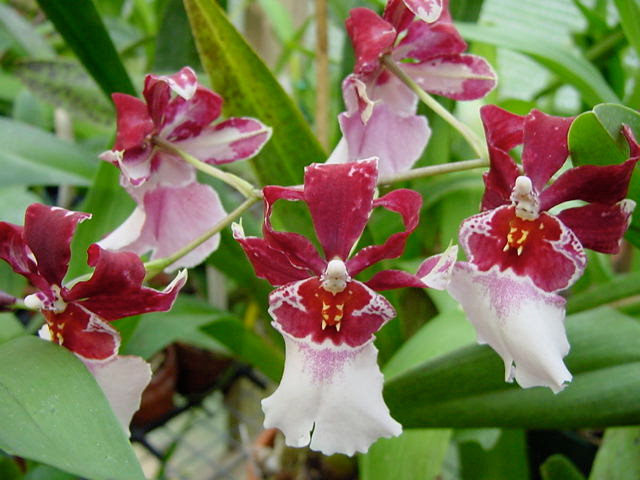Whether you know them as dancing dolls, dancing ballerinas or simply spray orchids, oncidiums and their related members in the
Oncidium alliance are popular both as long-blooming houseplants and long-lasting cut flowers. They may be a bit fussy about things like temperature humidity, but their beautiful sprays of flowers are worth the effort.
Many members of this alliance are easily hybridized with various crosses available. Some hybrid names will give a clue to the parent plants, such as
Odontocidium; others, such as
Maclellanara, have names that seem obscure at best. They generally have the same needs as their parents, but always check the care requirements for your specific orchid.

Jay Sifford Garden Design
The range of flower color for oncidiums isn’t quite as broad as with other orchids, although it is increasing with more hybridization. Yellow and red flowers are the most common, though there are some in shades of white, pink or lavender.
Unlike many other orchids, bloom times occur almost any time of year, depending on the species or hybrid. You may even get more than one bloom time per year with some. Care will vary depending on whether they’re actively growing, getting ready to bloom or resting, which is during and after their bloom.

Oncidium flower stalks seem to fall into two categories: upright and drooping. The upright ones can reach over 5 feet in height, though some are much smaller. Grow these in a pot and stake the flower stalks. Others may have arching stems, some of which are equally long, but they gracefully droop. These are a good choice to try in a hanging basket, where you can appreciate their flowers. You can also try mounting the smaller oncidiums on a piece of bark or wood.
Oncidiums love bright light while they’re growing; some can even take direct light in the morning during this time. Once they begin to bloom, though, you may need to move them into an area without the direct sunlight so their blossoms aren’t sunburned. Experiment a bit to find just the right spot.

Jay Sifford Garden Design
What makes oncidiums a bit more of a challenge for growing indoors is their need for fairly warm temperatures and a good amount of humidity. Temperatures while they’re actively growing should be between 80 and 85 degrees Fahrenheit (27 and 29 degrees Celsius) during the daytime and 55 to 65 degrees Fahrenheit (13 to 18 degrees Celsius) at night. Since these might be uncomfortable for people, you might want to look into a good space outdoors, or even a small greenhouse, or dedicate a growing area within your home.
The humidity levels that oncidiums prefer are also often higher than most people would like, between 30 and 60 percent. Growing them on pebble trays, being sure the roots don’t sit in water, is the best approach if you don’t have a greenhouse. Also provide plenty of air circulation.

Jay Sifford Garden Design
Oncidiums love moisture, but wet roots or bulbs will lead to rot. Rather than having them sit in water, flood the pot regularly and let the water completely drain out. Water once a week during the growing season to start, but if the potting medium is drying out and the bulbs are withering, then water more often. Cut back on watering to about half of what you had been doing once the plant is blooming or resting. Always water with tepid rain or tap water; softened water will kill plants.
Growers vary on what they recommend for feeding oncidiums, with some preferring a balanced fertilizer while others arguing for higher nitrogen levels while they’re growing. Go with your grower’s recommendation. If you’re not sure, start with a ¼ -strength liquid orchid fertilizer about once a week when the orchid is growing and adjust as needed. Cut back to every couple of weeks or even less when the plant is resting.

The New York Botanical Garden
Oncidiums do best in slightly smaller pots, but move them up to a slightly larger pot once they’ve stopped blooming if they are outgrowing their container, usually every couple of years. As with other epiphyte (air plant) orchids, oncidiums want a loose potting medium, preferably bark or something similar. When you do repot, place the plant against the edge of the pot rather than in the middle so it will spread outward in a single direction. Cut back the flower stalk once you’re sure that all the buds have bloomed and the stalk has died. If your oncidium isn’t reblooming, check the light and temperature first to see if that makes it happier.
More: Orchids 101: Get Started Growing Orchids at Home





